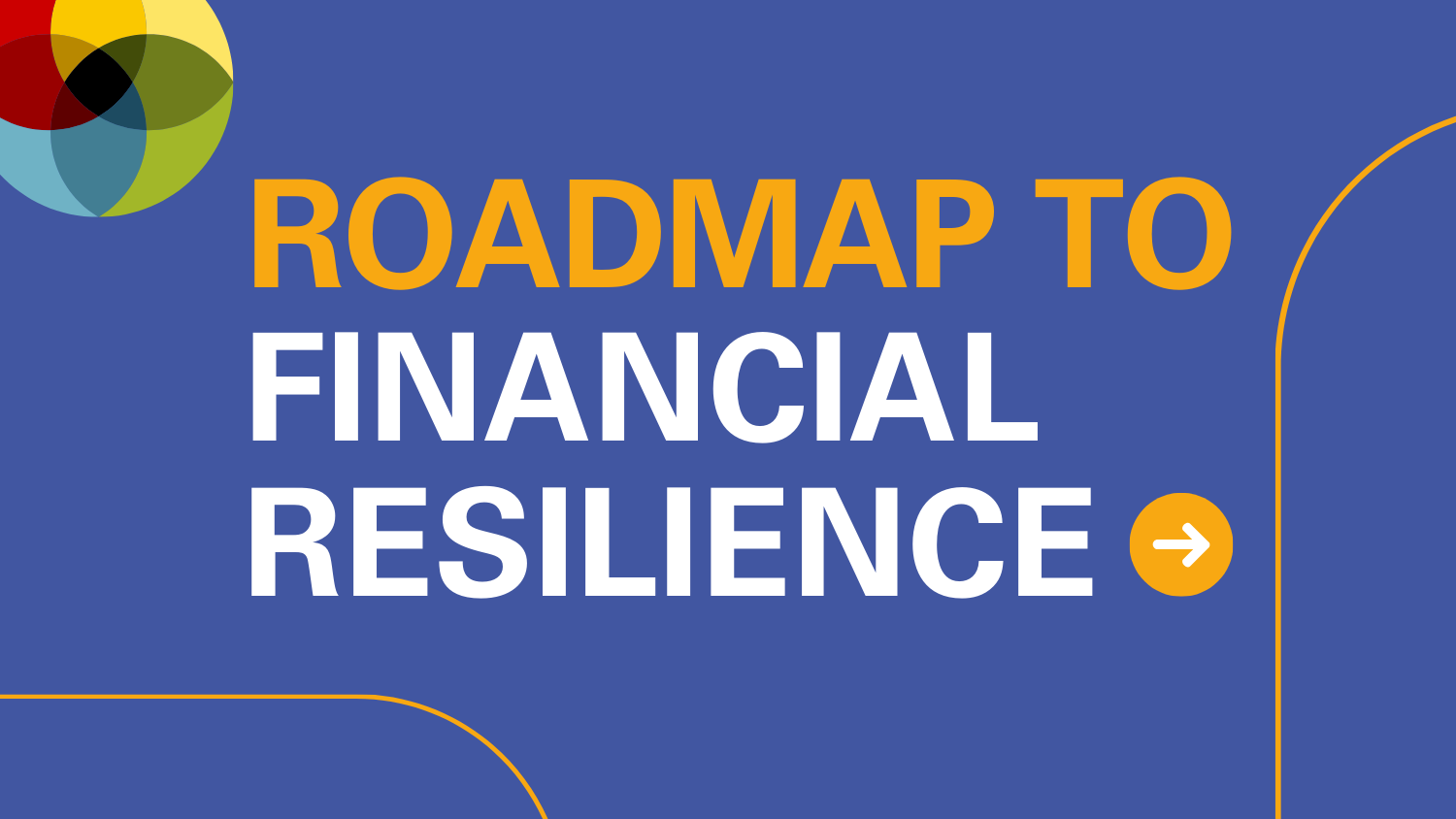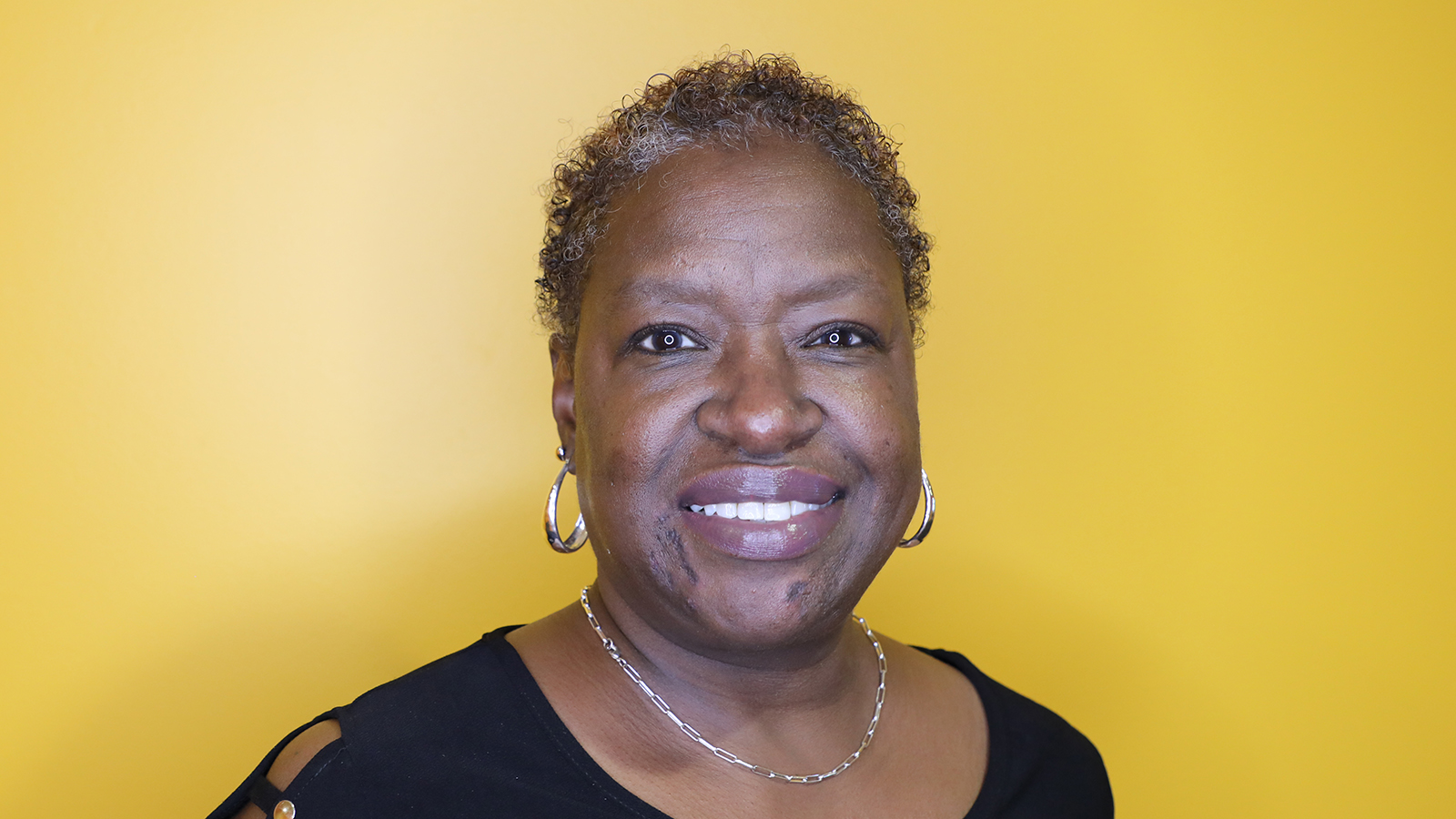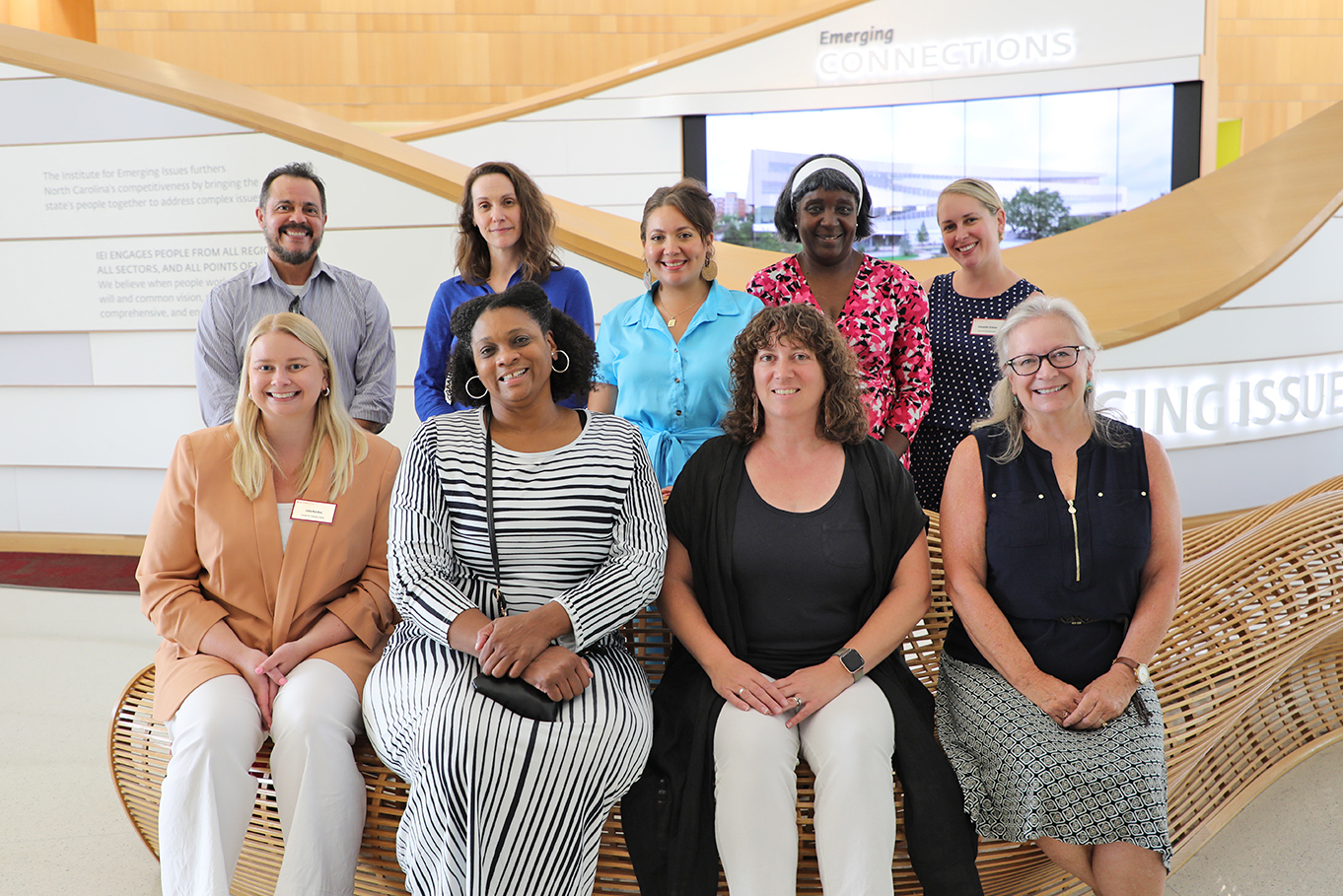The Employment of the Transitioning Military and their Families
Data Brief by Brodie Smith, IEI Policy Intern
Completed 12/22/2022
Who are the Transitioning Military and their Families?
Transitioning Military are individuals who are making the transition from military service to civilian life, including veterans, National Guard and Reserve members. This report will focus on these individuals as well as their families, specifically the spouses of service members. As multiple points of data in this document come from the American Community Survey, it is important to recognize that the U.S. Census Bureau defines “civilian veteran” as “a person 18 years old or over who has served, but is not now serving, on active duty in the U.S. Army, Navy, Air Force, Marine Corps, or the Coast Guard, or who served in the U.S. Merchant Marine during World War II. People who served in the National Guard or military Reserves are classified as veterans only if they were ever called or ordered to active duty.”
Highlights
- In 2021, there were approximately 615,500 veterans ages 18 and older in North Carolina.
- The highest rate of veterans in 2020 across all North Carolina counties (21.5%) was Onslow County, home to the Camp Lejeune Marine Corps Base and the Marine Corps Air Station New River.
- In 2019, 47% of post-9/11 veterans said that the transition from military service to civilian life was somewhat to very difficult.
- The unemployment rate for veterans by the end of 2021 was 4.4%; meanwhile that same year, the unemployment rate for Active Duty military spouses was 21%.
- On average, military families relocate, or have a permanent change of station, once every three years, requiring military spouses to frequently leave their current job on short notice.
National Data on Transitioning Military and their Families
As of 2021, there were approximately 16.5 million veterans (6.4%) in the United States civilian population, ages 18 years and older. This population of veterans varies greatly across sex, age, race and ethnicity, and disability status. By breaking this population down by sex, we see that veterans in the United States are predominantly male (90%), with females representing a much smaller portion of the population (10%). For the differences in age, we see that there were almost 8.4 million veterans ages 18 to 64 years (50.8%), with about 8.1 million veterans being 65 years old and older (49.2%).
To examine this population by race and ethnicity, we see that over 12.3 million veterans (74.7%) in the U.S. were White, making up nearly three-fourths of the veteran population. The next largest groups were Black veterans with 2 million people (12.3%), Hispanic or Latino veterans with 1.4 million people (8.2%), Asian veterans with 313,000 people (1.9%), Native American veterans with 121,000 people (0.7%), and Native Hawaiian or Pacific Islander veterans with 34,000 people (0.2%).
Disability status is also an important factor when it comes to veterans in the U.S., with approximately 4.9 million veterans (30.1%) having a disability and about 11.4 million veterans (69.9%) having no disability.
Outside of those strictly with veteran status, the United States Department of Defense reports that each year, over 200,000 Service members leave the military, transitioning back to civilian life.
According to data from the U.S. Department of Defense, in 2020 there were approximately 950,900 military spouses, which included spouses of Service members in Active Duty, the National Reserves and the National Guard. Of these military spouses, females accounted for 88.8% of the population, with males making up 11.2%. In the same year, the average age of a military spouse was 33.7 years old. Individuals married to Active Duty members accounted for 62.9% (about 597,700) of the total military force spouse population.
North Carolina Data on Transitioning Military and their Families
North Carolina has one of the largest military footprints of any state in the country with eight military bases, including Fort Bragg, one of the world’s largest military complexes. The North Carolina Department of Military and Veteran Affairs reports that military and defense industries are the second largest employers in our state, with the military having an economic impact of $66 billion annually.
When we zoom in on North Carolina, we see that in 2021 there were approximately 615,500 veterans in the civilian population ages 18 years and older. Just as on the national level, the North Carolina population of veterans varies across sex, age, race and ethnicity, and disability status. When we view this population of veterans separated by sex, we see that males still hold a majority, representing 88.2% of the population while their female counterparts accounted for 11.8%. By breaking this group down by age, we see that 336,100 veterans (54.6%) fall between the ages of 18 and 64, and about 279,400 (45.4%) being 65 years old or older. Similar to the entire United States veteran population, about 3 in 10 veterans in North Carolina had a disability totaling at approximately 180,900 individuals (29.6%).
Within this population, approximately 431,800 veterans (70.2%) were White, coming in as the largest group of veterans in North Carolina. The second largest group were Black veterans with about 131,500 (21.4%), accounting for 1 in every 5 veterans in North Carolina which was almost twice that of the national level. Hispanic or Latino veterans came in with the third largest group of veterans with almost 24,600 people (4.0%). Unlike the national level, Native American veterans were the fourth largest group with just over 5,300 individuals (0.9%), with Asian veterans trailing not too far behind with about 3,500 people (0.6%).
In 2021, the U.S. Department of Defense reported that there were approximately 54,200 spouses married to Service members in the total military force in North Carolina. Of these spouses, 7.5% were male with the majority being female at 92.5%, and the average age of these spouses was 31.7 years old. Of the total military force spouse population in North Carolina, 81.7% (about 44,300) of them were married to Active Duty service members. See Figure 1 to learn more about Active Duty Military Spouses and the demographics of this population.
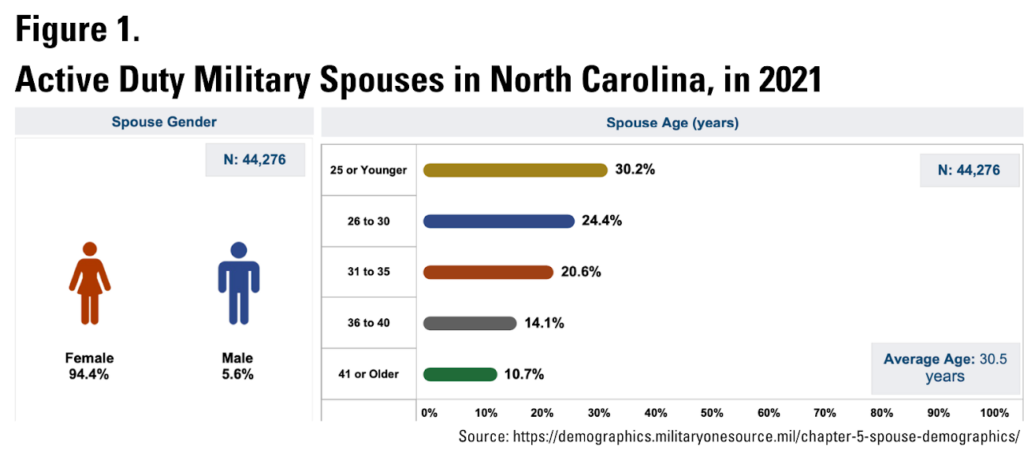
County Data on Transitioning Military and their Families
The percentage of veterans in each North Carolina county varies greatly. With North Carolina having eight military bases spread across multiple counties, it is no surprise that those counties with bases have the highest percentages of veterans, four of which are in the top five. Counties that house military bases in North Carolina are Cumberland, Onslow, Hoke, Wayne, Richmond, Craven, Brunswick and Pasquotank.
Onslow County, which is home to the Camp Lejeune Marine Corps Base and the Marine Corps Air Station New River, with 21.5% of their 18 year and older population being veterans making them the county with the highest percentage of veterans in the state. For the rest of the top five counties with the highest percentage of veterans, right behind Onslow is Cumberland County (19.2%), then Hoke County (16.3%), then Craven County (15.9%), and trailing right behind, Camden County (15.8%). To see how all the counties in North Carolina compare to each other, see the map in Figure 2.
With military spouses typically living with their Active Duty partners, through either on-base housing or off-base housing with housing allowances, it can be inferred that the majority of Military Spouses reside in counties that contain an active military base.
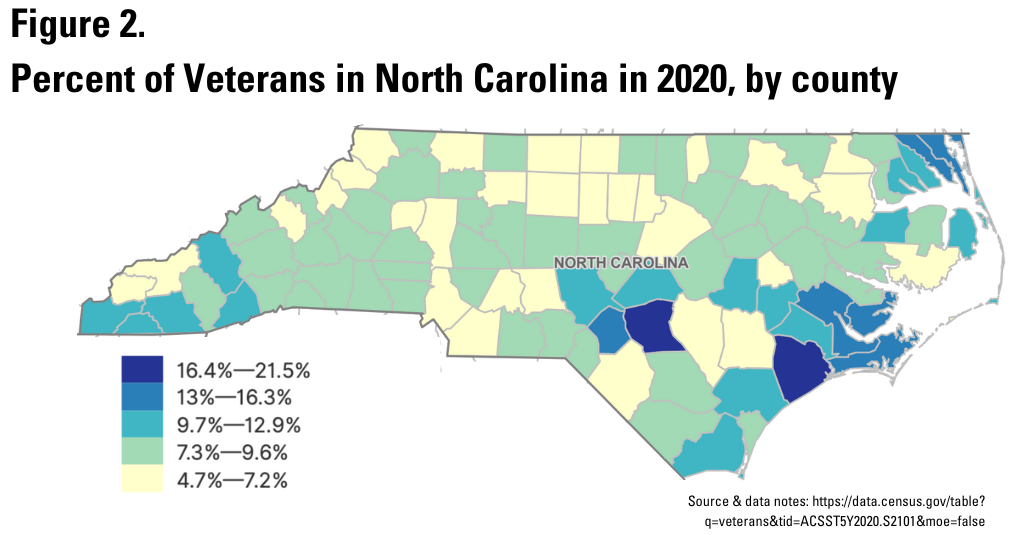
Employment Data on Transitioning Military and their Families
Now that we have explored how transitioning military, veterans and military spouses are represented in the national, state and local levels, let us now examine how these individuals are employed across North Carolina and the United States. In 2019, the Pew Research Center released a report on the experience of individuals who transitioned from military service to civilian life. This report stated that 1-in-4 veterans had a civilian job lined up prior to their separation from the military. For the other three-fourths of veterans, 48% said they began looking for a job immediately after leaving the military, 21% said they looked for a job but not right away, and 5% did not look for a job or they retired. Of those veterans who searched for a job, only about half of them said they found their first job within six months of departing from the military. To learn more about veterans’ ability to find jobs after transitioning to civilian life, view Figure 3. It was also found that 28% of veterans said they had received unemployment compensation in the first few years after leaving the military.
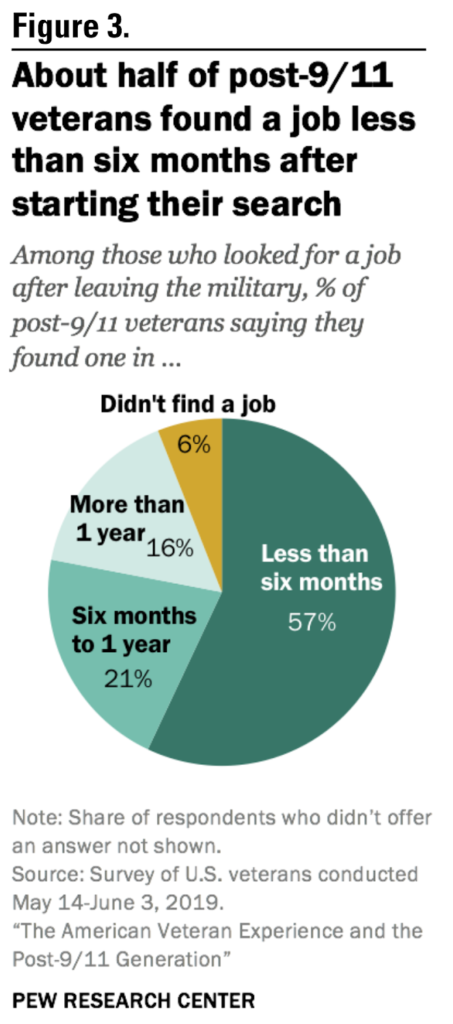
The Bureau of Labor Statistics reported that the unemployment rate for veterans across the United States declined to 4.4% in 2021, which was lower than that of nonveterans in the same year (5.3%). However, the labor force participation rate of veterans was much lower than that of nonveterans (47.7% vs. 64.1%). The unemployment rate for male and female veterans had a marginal difference, 4.4% and 4.2% respectively. When looking at this data separated by race and ethnicity, we see that Asian veterans had the lowest unemployment rate at 3.8%, followed by White veterans at 4.2%, then Black veterans at 5.0%, and finally Hispanic or Latino veterans at 6.0%. Employment data by state revealed that North Carolina had the tenth lowest unemployment rate for veterans at 2.8%.
While the national unemployment rate for veterans in 2021 was lower than that of nonveterans, spouses of those currently serving in the military were not as fortunate. The United States Department of Defense reported that in 2021, the unemployment rate for those married to Active Duty service members was 21%, nearly five times more than the total civilian population in the same year. That means that 1-in-5 Active Duty military spouses were unemployed in 2021. For spouses of Selected Reserve service members, the unemployment rate was lower than their Active Duty counterparts, yet it was still almost twice that of the civilian population at 7%.
Barriers to Employment
The transition from military service to civilian life can be difficult. According to a survey from Pew Research Center, 47% of post-9/11 veterans said that the transition from military service to civilian life was somewhat to very difficult. Additionally, 32% of veterans said that they had difficulty dealing with the lack of structure in civilian life within the first few years after leaving the military. Forty-five percent of the veterans surveyed said that the military did not properly prepare them for the transition to civilian life, and only 33% of post-9/11 veterans felt optimistic about their future. In a study published by University of Southern California’s Center for Innovation and Research in Veterans and Military Families, the most prominent barriers to employment for veterans are the lack of transition support or negative experiences with support services, leaving on less than honorable discharge, the feeling of entirely starting over, perceived employer and societal stigma and discrimination, and lack of personal planning and preparation due to organizational barriers.
With military families moving on average every three years, called a permanent change of station (PCS), it becomes extremely difficult for military spouses to advance in their careers. When a military family has a PCS move, the spouse has to frequently and sometimes on short notice leave their job, and with the hiring process sometimes being lengthy, it can potentially leave a spouse with about one to two years of employment before having to move again. If the family has young children, then childcare can act as a barrier since the costs are oftentimes too high and would be more affordable if the spouse just stayed home with the children.
Policies and Programs Surrounding Transitioning Military and their Families
There are several policies and no shortage of programs across the United States and North Carolina that are focused on assisting those who are making the transition from military service to civilian life, as well as the spouses who are married to active military members. These policies and programs cover multiple areas of support for these individuals, including some that are centered around the employment of these people. To read more about the policies and programs for transitioning military and their families, check them out below:
The Uniformed Services Employment and Reemployment Rights Act of 1994 (USERRA)
THe USERRA is a federal policy that prohibits the discrimination in employment based on one’s prior service in the uniformed services, current service in the uniformed services, or the intent to join the uniformed services. This act protects the rights of those connected to military service and applies to private employers, the Federal government, State and local governments, United States employers who are operating overseas, and foreign employers who are operating within the United States.
Jobs for Veterans State Grants (JVSG)
The Jobs for Veterans State Grants (JVSG) program provides federal funding for State Workforce Agencies to hire dedicated staff responsible for providing individualized career and training services to eligible veterans. This program also provides assistance to employers by helping them fill their workforce needs with job-seeking veterans. The JVSG funding supports the Disabled Veterans’ Outreach Program specialist position, Local Veterans’ Employment Representative staff, and various other staff positions. In North Carolina, this program is administered by the North Carolina Department of Commerce’s Division of Workforce Solutions who provides a Veteran Services Program across the state to assist veterans with employment.
Transition Assistance Program (TAP)
The Transition Assistance Program (TAP) is a cooperative effort between the Department of Labor, and the Departments of Defense, Education, Homeland Security and Veterans Affairs, the Small Business Administration and the Office of Personnel Management. TAP provides resources and training services to equip service members and their spouses for the transition to civilian life. Resources available from TAP include workshops on employment preparation, career exploration, and technical career preparation, and various online courses encompassing a broad array of topics.
Spouse Education and Career Opportunities (SECO)
The Spouse Education and Career Opportunities (SECO) program provides educational resources and career guidance to military spouses worldwide. SECO offers comprehensive resources and tools related to career exploration, education, training and licensing, employment readiness and career connections. Military spouses are given the opportunity to meet with career coaches covering a broad range of career readiness topics, as well as participate in the Military Spouse Employment Partnership, a program that connects participants with employers who are committed to recruiting, hiring, and retaining military spouses.
Success in Action
North Carolina for Military Employment (NC4ME) is a comprehensive public-private partnership established by Governor Roy Cooper in 2015. This partnership is designed to make North Carolina the number one state for military employment, accomplished by leveraging existing workforce development resources and technology to implement an employer-centric strategy. Through their work, NC4ME has provided services for over 8,300 service members and military spouses, over 9,900 career connections have been made through NC4ME events and programs, more than 8,900 leaders in business and communities have learned the value of hiring military talent, and about 52% of those who have taken advantage of the NC4ME programs and resources had interviews that resulted in job offers or second interviews.
The North Carolina Military Business Center (NCMBC) is a statewide business development and technology transition entity of the North Carolina Community College System, headquartered at Fayetteville Technical Community College. The NCMBC leverages military and other federal business opportunities to expand the economy, grow jobs and improve the quality of life for North Carolinians. One major goal of the NCMBC is supporting the integration of highly skilled, transitioning military personnel, family members and veterans into the state workforce. Since their opening in 2005, the NCMBC has continued to work for the military community, through recruiting defense-related business to North Carolina and providing connections to employment for transitioning military, their families and veterans.
The Veterans Legal Clinic at Wake Forest University’s Law School provides critical assistance to low income former service members to correct injustices in their records. Through the work of this clinic, students and faculty at Wake Forest University have successfully made differences in the lives of numerous veterans, allowing them to have an easier transition to civilian life. One way they have done this is through representing veterans in cases where they may have left the military on less than honorable discharge, and persuading the Army board to change the individual’s discharge to Honorable, allowing them to have access to numerous resources and programs from the Department of Veterans Affairs.
The Employment Readiness Program (ERP) at Fort Bragg works to provide career services to military spouses, military family members, retirees, Department of Defense civilians, Active Duty military, Active Reserve members, National Guard members and Wounded Warriors. The services that the ERP provides include hiring events and job fairs, assistance with employment applications, career and résumé counseling with Certified Career Counselors, classes and seminars on a wide variety of topics, and many other resources available to those who are seeking employment.
Hiring Our Heroes (HOH) is an initiative that started under the U.S. Chamber of Commerce Foundation, and works to connect the military community—active service members, military spouses and veterans—with American businesses to create economic opportunity and a strong, diversified workforce. HOH provides a wide array of services for the military community, including professional development events, educational programs, networking opportunities, hiring events and fellowship programs where participants receive professional training and hands-on experience. HOH has also created the Military Spouse Professional Network (MSPN) which connects military spouses with established networks, giving them access to local business leaders, peers and mentors, while also supporting their career development through various other programs. More than 1,400 hiring events have taken place in every U.S. state, as well as on military installations in Germany, Italy, Japan and Puerto Rico, with a job offer rate of 43% at in-person events in 2019. More than 3,500 individuals in the military community are participating in Google Career Certificate programs through HOH, covering data analytics, IT support, digital marketing and much more.
- Categories:
